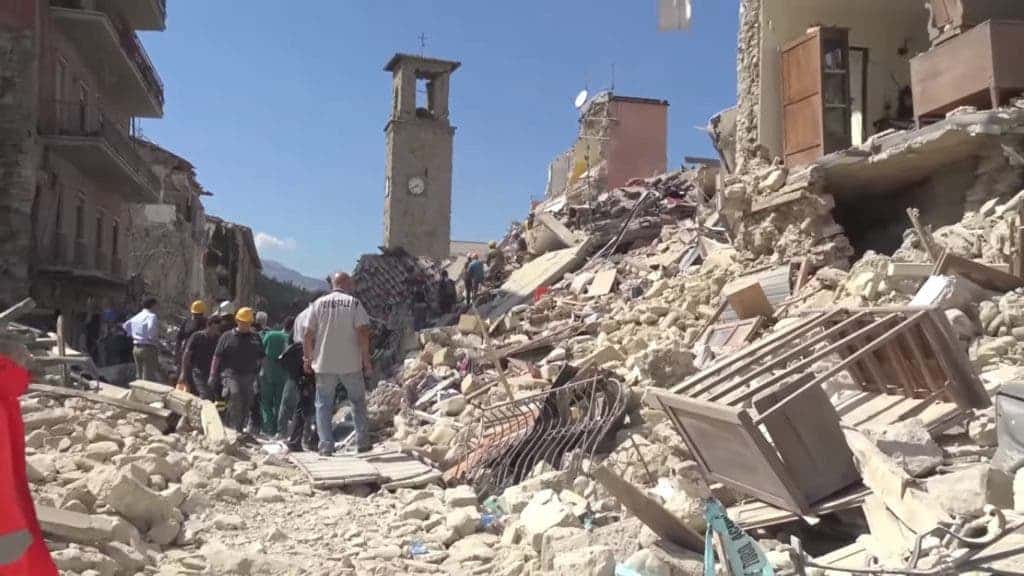
An aftershock is like an echo — a smaller earthquake that occurs soon after a larger one, hitting the same area as the main shock. Large magnitude quakes can generate aftershocks of varying magnitudes over a period of months. For people living and working around the site of an earthquake, the subsequent days and weeks are filled with anxiety — when will there be a new one?
Seismologists have crafted models that fairly accurately predict when an aftershock is going to take place and how violent (i.e. magnitude) it will be. Now, researchers at Google and Harvard have teamed up to produce an artificial intelligence system that can also predict where the aftershock will hit next.
The collaboration devised an AI that was fed a database of 131,000 earthquakes and the location of their subsequent aftershocks. The machine learning algorithm was instructed to spot the patterns in this complex landscape of variables upon variables.
There are a lot of things that shape a seismic event — from the composition of the ground to the interactions between tectonic plates to the ways seismic waves propagate through the Earth. Making sense of all the intricate layers upon layers can be maddening. However, this sort of high-volume pattern matching is what machine learning algorithms excel at. Such AIs are currently being used by tech giants like Facebook, Amazon, and Google to sell you virtual assistants or to show search results.
“After earthquakes of magnitude 5 or larger, people spend a great deal of time mapping which part of the fault slipped and how much it moved,” said Brendan Meade, a Professor of Earth and Planetary Sciences at Harvard University.
“Many studies might use observations from one or two earthquakes, but we used the whole database…and we combined it with a physics-based model of how the Earth will be stressed and strained after the earthquake, with the idea being that the stresses and strains caused by the main shock may be what trigger the aftershocks.”
Meade was first inspired to neural networks to predict aftershocks several years ago during his two sabbaticals at Google in Cambridge. At the time, deep learning algorithms were not as established as they are today but the idea immediately sounded too good to pass.
After years of work, Meade and colleagues came up with a model which has much better predictive power than anything before it. On a scale of accuracy from 0 to 1 — where 1 is a perfectly accurate model and 0.5 is essentially the accuracy of flipping a coin — the new AI system scored 0.849 while the previously most precise model scored only 0.583.
The neural network was able to work so well thanks a little quirk it managed to uncover all by itself. The complex calculations take into consideration a factor known as the “von Mises yield criterion”, which predicts when a material will break under a stress. It’s been mostly used by engineers in the field of metallurgy. Now, it has also found its place in earthquake science, the authors reported in the journal Nature.
“This is a quantity that occurs in metallurgy and other theories, but has never been popular in earthquake science,” Meade said. “But what that means is the neural network didn’t come up with something crazy, it came up with something that was highly interpretable. It was able to identify what physics we should be looking at, which is pretty cool.”
Another advantage of the new AI is that it works for different types of faults. Because it’s generalizable, the system can just as well predict aftershocks around slip-faults, such as those seen in California, or shallow subduction zones, as seen in Japan.
Before you get overly excited though, be aware that this AI has a number of important limitations. The system only works with aftershocks caused by permanent changes to the ground, so-called static stresses. Aftershocks, however, can also be triggered by dynamic stresses that do not permanently change the applied load and thus can trigger earthquakes only by altering the mechanical state or properties of the fault zone.
The AI is also too slow to work in real-time, which is a must-have considering that most aftershocks occur in the first day following an important earthquake.
Going forward, the researchers hope to overcome these challenges one by one. What’s more, Meade also has his mind set to predicting the magnitude of earthquakes themselves — something which is still considered highly esoteric and, perhaps, impossible to do.
“I think there’s a quiet revolution in thinking about earthquake prediction,” he said. “It’s not an idea that’s totally out there anymore. And while this result is interesting, I think this is part of a revolution in general about rebuilding all of science in the artificial intelligence era.
“Problems that are dauntingly hard are extremely accessible these days,” he continued. “That’s not just due to computing power — the scientific community is going to benefit tremendously from this because…AI sounds extremely daunting, but it’s actually not. It’s an extraordinarily democratizing type of computing, and I think a lot of people are beginning to get that.”






